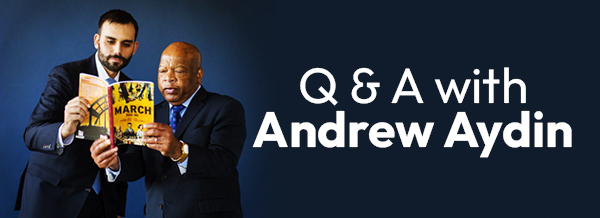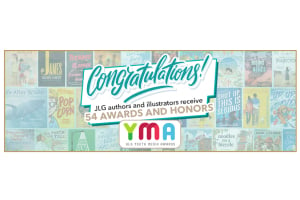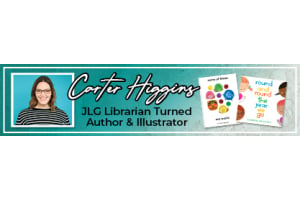Q & A with Andrew Aydin



To honor the anniversary of Selma’s Bloody Sunday, a nonviolent march during the Civil Rights Movement, we sat down and spoke with JLG author, Andrew Aydin. We first met Aydin at ALA in 2022; he was gregarious, genuine, and found a way to connect with each attendee on a personal and professional level. He spoke openly and humbly, sharing his experiences with Congressman John Lewis, a champion for human rights and one of the “Big Six” leaders of the Civil Rights Movement.
Aydin and Lewis co-authored the series RUN and MARCH, which are sequential nonfiction narratives. They first met when Aydin was hired to answer Lewis’s mail and became close colleagues and friends as they worked to represent Georgia's Fifth Congressional District. Their first graphic novel went on to become a New York Times Best Seller in 2017. Their books have won many awards, and Aydin continues to carry out Lewis’s legacy in both his policy making and book writing.
Q: Why did you and John Lewis decide to write a book together?
A: Congressman Lewis and I worked very closely together, in fact, he asked me to serve as his press secretary on his reelection campaign in 2008. After that, we were inseparable. I came up with the idea for Lewis to write a book because people didn't really know what he had done during the Civil Rights Movement, and he faced many challenges in his reelection campaigns. I wanted people to see the culmination of events that made Lewis a brave and brilliant leader—so I suggested he write a book, and naturally, my love for comics shined through.
Q: Love for comics? Tell us more!
A: I was raised by a single mother and my father was a Turkish Muslim immigrant who left when I was very young. Being an only child of a single mother, you know, was very difficult and I was often angry; I wondered to myself, was it my fault that my father left? I felt those family dynamics in many ways, and reading comics was my escape. I read tons of titles that my grandma gave me—comic books from when my uncle was growing up. So really, my grandma is to blame for my interest in comics. I remember the first brand-new comic book she ever bought me was from a Piggly Wiggly in North Carolina.
Q: Tell us a little bit about the history that RUN and MARCH depict. Was Selma’s Bloody Sunday a big plot point for your stories?
A: You know, many people see Bloody Sunday as a singular event—but it’s not, it’s really the events that led up to Bloody Sunday that make it so life-changing. It’s sad that many people don’t see it that way, so if you’re able to read the books, you will learn so much more. People will learn how the student movement led to the Freedom Rides, and how the Freedom Rides made the March on Washington possible, and how the weaknesses of the Civil Rights Act of 1964 forced young people to respond with the Mississippi Freedom Summer and how they challenged the Democratic Convention in Atlantic City… those events are what make up Selma’s Bloody Sunday. Lewis was such a perfect role model for what it is to be a young person devoted to their beliefs and willing to fight for it nonviolently.
Q: How did you use primary documents to recreate scenes of historic events in your books?
A: It took a lot of convincing for people to believe that a comic book or a graphic novel could be significant in the literary community. There was just a lot of prejudice against that idea. We started using primary documents to recreate scenes throughout history as if they were in the moment, which no one had done before in comics— not of historic events. You know, sometimes people do that as memoir, but in terms of a large historic piece, nobody had done that yet.
We’re very fortunate that at the time, a number of historical records were being digitized and uploaded onto the Internet for the very first time, so we were able to find these newly scanned and indexed documents more readily than would have been possible otherwise. We ended up using countless documents.
Take the scene in book two when they're in the church under siege and there's a conversation between Robert Kennedy and Doctor King. That section was based on a transcript that the Justice Department had created, and so we were able to reproduce that—verbatim. Using primary documents to create our novels was key to their success.
Q: What makes sequential nonfiction narratives so unique and impactful to young readers?
A: I think that we’re able to teach concepts to young people very quickly through comics and graphic novels. We can take these genres and make topics very digestible for young people; words and pictures working together convey more information than either would convey by themselves. At the same time, this generation has grown up on the Internet; they communicate differently than any generation before because they're digital natives—because their first language is sequential narrative. If you want to reach this generation as effectively and efficiently as possible, you must do it in sequential narrative—which makes the skill of creating nonfiction sequential narratives all the more important. What we bring to life in comics, emphasizes critical learning skills that other forms of literature may not. The RUN and MARCH series for example, encourages readers to think about and question how we evaluate historical documents—which is a lifelong skill.
Q: Why should young people read your books?
A: These books, which hold such powerful themes, give young people the opportunity to see themselves as participants of a movement. All too often, we see characters in stories as if they're gods or kings, but the MARCH series specifically allows young people to see themselves in the characters—to be a part of the action. Students who read these books will understand how important their actions are—that they can affect change through nonviolent civil disobedience. They will understand how they can change our laws someday, how they have the power to change our culture. We all need a little hope. We all need to see how another generation carved a path out of nothing, how time and time again they were told no or that they couldn’t do something—and that's what MARCH shows us, that there was a generation that faced seemingly unbeatable odds and yet, they prevailed. These books remind us that progress only continues if we devote ourselves to it; the young people of the Civil Rights Movement devoted themselves perhaps more strongly than any generation before, and their example is something that we all need.
Q: What did you love most about working with John Lewis?
A: For all the seriousness that John conveyed in his life, he also had a tremendous sense of humor. He was able to goof around and find humor in difficult situations. John loved to dance, be happy, and laugh. I mean, he was the most positive and optimistic person even in some of our darkest moments. When we we’re in the office, he would take these little bags of jellybeans and just throw them up in the air and they would come down on your desk while you were working. You’d be startled and look up and just say, “Oh, well, hello sir!”.
I remember Congressman would tell me stories about Doctor King and how they would try and relax the night before a protest, make light of what would soon be so heavy. They would sit around and tease each other—they called it clowning on each other. One of the things they would do is give mocking eulogies of each other. It would be something like Doctor King saying, “Oohh John Lewis, he may be small in stature but he's a giant of a man,” you know, because he was short!
I'll never forget the first time he saw a copy of March: Book One, and I handed it to him. He held it up into the air and kissed it. He said it was like it had always existed and I had just now pulled it down from the heavens and brought it to us. In that beautiful moment, I'm wearing a white shirt, and we hug each other and he's crying. He pulls back and there's a John Lewis face right on my shirt! He had just been on a talk show, and they had done his makeup beforehand. John got so embarrassed, he said, “I’ll buy you a new shirt,” and I was like, “Congressman, who cares? You know, we just pulled off what everyone said was impossible!”. He just took that much joy out of it, and it just meant so much to him.
Q: What advice do you have for young, aspiring writers?
A: You know, I think it’s so hard to become a published writer. You must believe so deeply in the story that you're trying to tell that you absolutely cannot be deterred. I had John Lewis to look up to, of all people, and you know his story and how he's so important, and yet, almost all the publishers told us no—said that they didn’t see value in these stories. That's what you're up against. You must be clear-eyed about that, and that's why you must believe so deeply that your story must be told.
Breaking into this world is not easy, especially for those of us who grew up poor or without introductions or connections. You must work, and you have to work hard, and you have to believe and be persistent. You also have to read—I read a lot of comic books, studied them, tried to figure out the best approach. If you want to be a great writer, read what you want to write. Study the other creators—you’ll learn so much. If you can't understand how it was done before you, then you don't have an understanding of how to do it in your own way.
MARCH and RUN were past JLG selections. You can shop similar titles on our website.









